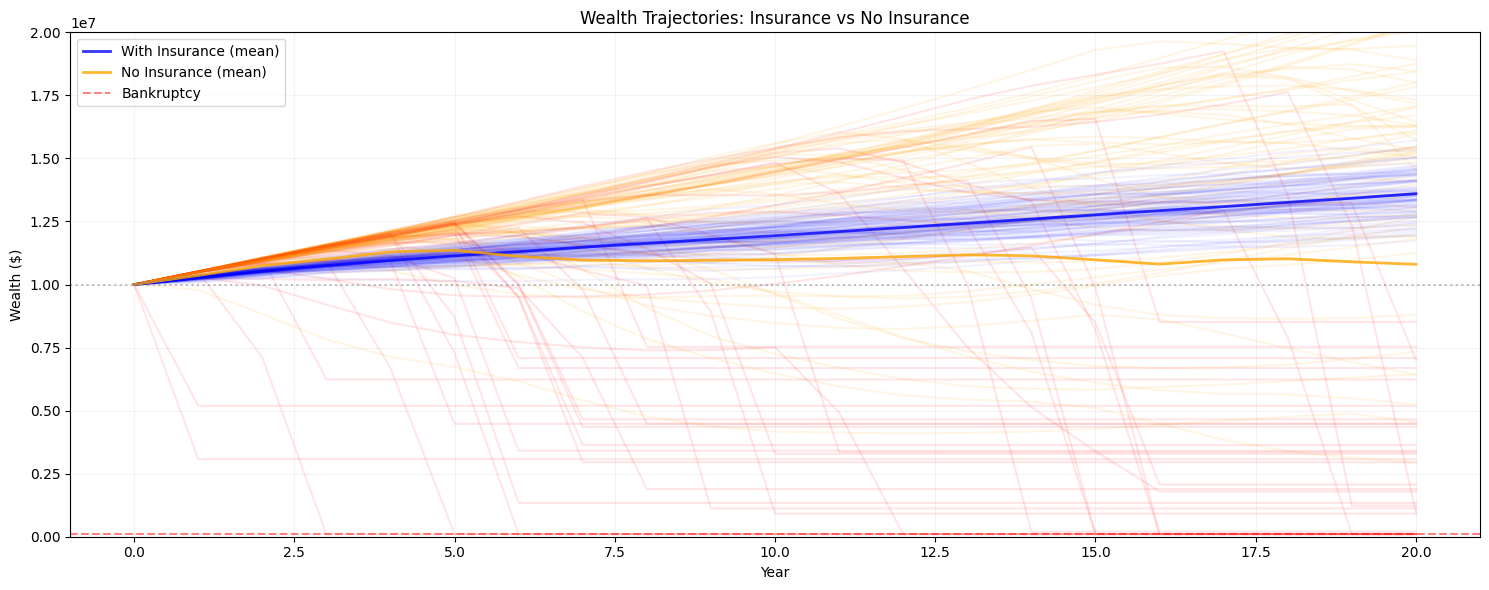Getting Started
Installation
Clone the Repository:
git clone https://github.com/AlexFiliakov/Ergodic-Insurance-Limits.git cd Ergodic-Insurance-Limits/ergodic_insurance
Install Dependencies
Using uv (recommended):
uv sync
Or using pip:
pip install -e .
Install Development Dependencies (optional):
uv sync --extra dev --extra notebooks --extra docs
Verify Installation:
python -c "import ergodic_insurance; print('Installation successful')"
Quick Example
Here’s a simple example to get you started:
from ergodic_insurance.manufacturer import WidgetManufacturer
from ergodic_insurance.claim_generator import ClaimGenerator
from ergodic_insurance.manufacturer import WidgetManufacturer
from ergodic_insurance.config_v2 import ManufacturerConfig
# Create configuration
manufacturer_config = ManufacturerConfig(
initial_assets=10_000_000,
asset_turnover_ratio=1.0,
base_operating_margin=0.08,
tax_rate=0.25,
retention_ratio=0.8
)
# Create manufacturer
manufacturer = WidgetManufacturer(manufacturer_config)
revenue = manufacturer.total_assets * manufacturer_config.asset_turnover_ratio
# Two-tier loss structure to demonstrate insurance value:
# 1. Regular operational losses (frequent, manageable)
regular_generator = ClaimGenerator(
base_frequency=5.0 * (revenue / 10_000_000), # ~5 per year, scales with revenue
severity_mean=80_000, # Mean $80K
severity_std=50_000, # Moderate variation
seed=42
)
# 2. Catastrophic losses (rare but potentially ruinous)
catastrophic_generator = ClaimGenerator(
base_frequency=0.3 * (revenue / 10_000_000), # ~0.3 per year (once every 3 years)
severity_mean=2_000_000, # Mean $2M
severity_std=1_500_000, # Can reach $5M+
seed=43
)
# Generate both regular and catastrophic claims
regular_claims, _ = regular_generator.generate_enhanced_claims(
years=1,
revenue=revenue,
use_enhanced_distributions=False
)
catastrophic_claims, _ = catastrophic_generator.generate_enhanced_claims(
years=1,
revenue=revenue,
use_enhanced_distributions=False
)
# Combine all claims
all_claims = regular_claims + catastrophic_claims
# Calculate company's net loss after insurance
total_company_payment = 0
annual_premium = 100_000 # Annual insurance premium
for claim in all_claims:
claim_amount = claim.amount
if claim_amount <= 100_000:
# Below deductible, company pays all
company_payment = claim_amount
else:
# Above deductible, insurance covers rest up to limit
company_payment = 100_000 # Deductible
if claim_amount > 5_000_000:
company_payment += claim_amount - 5_000_000 # Excess over limit
total_company_payment += company_payment
# Apply losses to manufacturer using the apply_loss method
if total_company_payment > 0:
manufacturer.record_insurance_loss(total_company_payment)
# Check results
print(f"Final assets: ${manufacturer.total_assets:,.0f}")
print(f"Final equity: ${manufacturer.equity:,.0f}")
print(f"Survived: {manufacturer.total_assets > 0}")
Simulation Results

The graph above shows a 20-year simulation comparing wealth trajectories with and without insurance. Notice how insurance provides protection during catastrophic loss years (marked with orange lines), preventing bankruptcy and enabling steady long-term growth.
Configuration
The system uses YAML configuration files for parameter management:
- Baseline Configuration (
data/parameters/baseline.yaml) Standard parameters representing a typical widget manufacturer
- Conservative Configuration (
data/parameters/conservative.yaml) Lower growth, higher margins, more conservative assumptions
- Optimistic Configuration (
data/parameters/optimistic.yaml): Higher growth, aggressive assumptions for best-case scenarios
You can override any parameter programmatically:
# Create configuration with custom parameters
from ergodic_insurance.config_v2 import ManufacturerConfig
config = ManufacturerConfig(
initial_assets=10_000_000,
base_operating_margin=0.12, # Override default margin
asset_turnover_ratio=1.5,
tax_rate=0.25,
retention_ratio=0.7 # Retain 70% of earnings
)
Running Tests
Execute the test suite to ensure everything is working correctly:
# Run all tests
pytest
# Run with coverage
pytest --cov=ergodic_insurance --cov-report=html
# Run specific test file
pytest tests/test_manufacturer.py
Code Quality
The project includes comprehensive code quality tools:
Formatting:
black ergodic_insurance/
Linting:
pylint ergodic_insurance/
Type Checking:
mypy ergodic_insurance/
All Quality Checks:
pre-commit run --all-files
Next Steps
Read the Theoretical Foundations section to understand the ergodic framework
Explore the Examples for more complex usage patterns
Check the ergodic_insurance for detailed API documentation
Run the Jupyter notebooks in
notebooks/for interactive exploration